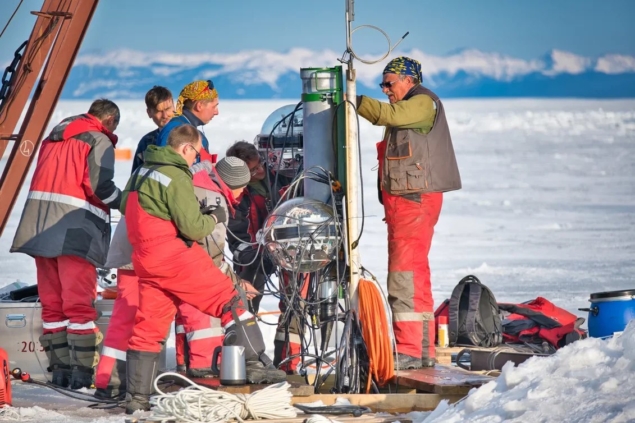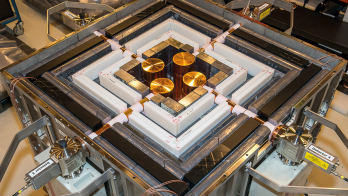Fifty years after being established, the Institute for Nuclear Research in Moscow continues to leave its mark on neutrino and high-energy physics.

Founded on 24 December 1970, the Institute for Nuclear Research of the Russian Academy of Sciences (INR RAS) is a large centre for particle physics in Moscow with wide participation in international projects. The INR RAS conducts work on cosmology, neutrino physics, astrophysics, high-energy physics, accelerator physics and technology, neutron research and nuclear medicine. It is most well-known for its unique research facilities that are spread all across Russia, and its large-scale collaborations in neutrino and high-energy physics. This includes experiments such as the Baksan Neutrino Observatory, and collaborations with a number of CERN experiments including CMS, ALICE, LHCb, NA61 and NA64.
The Institute was founded by the Decree of the Presidium of the USSR Academy of Sciences in accordance with the decision of the government. Theoretical physicist Moisey Markov had a crucial role in establishing the Institute and influenced the research that would later be undertaken. His ambition is seen in the decision to base INR RAS on three separate nuclear laboratories of the P.N. Lebedev Institute of Physics of the Academy of Sciences of the USSR. Each laboratory had a leading physicist in charge: the Atomic Nucleus Laboratory headed by Nobel laureate Ilya Frank; the Photonuclear Reactions Laboratory under the direction of Lyubov Lazareva; and a neutrino laboratory headed by Georgy Zatsepin and Alexander Chudakov. The man overseeing it all was the first director of INR RAS, Albert Tavkhelidze, a former researcher at the Joint Institute for Nuclear Research (JINR, Dubna). In 1987 he was replaced as director by Victor Matveev, then in 2014 by Leonid Kravchuk. Since 2020 the director of INR RAS is Maxim Libanov.
It (Troitsk) has the most powerful linear proton accelerator in the Euro-Asian region
From the very beginning, major efforts were focused on the construction and operation of large-scale research facilities. The hub of INR RAS was built 20 km outside of Moscow, in a town called Troitsk. In 1973 an accelerator division was created, with a long-term goal of creating a meson facility that would house a 600 MeV linear accelerator for protons and H- ions. The first beam was eventually accelerated to 20 MeV in 1988 and the facility was fully operational by 1993. Now known as the Moscow Meson Facility, it has the most powerful linear proton accelerator in the Euro-Asian region, providing fundamental and applied research in nuclear and neutron physics, condensed matter, development of technologies for the production of a wide range of radioisotopes, operation of a radiation therapy complex and many other applications.
A town called Neutrino
Over 1000 miles south from the Troitsk laboratory, an underground tunnel in the Caucasus mountains is the base of another INR RAS facility, the Baksan Neutrino Observatory (BNO). The facility was established in 1967 and the Baksan Underground Scintillation Telescope (BUST) started taking data in 1978. A town sensibly called “Neytrino” (Russian for neutrino) was constructed in parallel with the facility, and was where scientists and their families could live 1700 m above sea level next to the observatory. In 1987 BUST was one of the four neutrino detectors to first directly observe neutrinos from supernova SN1987A.
The observatory did not finish there, and the next step was the gallium-germanium neutrino telescope (GGNT), which was home to the Soviet–American Gallium Experiment (SAGE). The experiment contributed heavily towards solving the solar neutrino problem and simultaneously gave rise to a new problem known as the gallium anomaly, which is yet to be explained. SAGE is still well and truly alive, and with a recent upgrade of the GGNT completed in 2019, the team will now hunt for sterile neutrinos.

By 1990 another neutrino detector was under construction, following the original proposal of Markov and Chudakov. In collaboration with JINR, plans for an underwater neutrino telescope located at the world’s largest freshwater lake, Lake Baikal, took shape. Underwater telescopes use glass spheres that house photomultiplier tubes to detect Cherenkov light from the charged particles emerging from neutrino interactions in the lake water. The first detector developed for Lake Baikal was the NT200, which was constructed over five years from 1993–1998 and detected cosmic neutrinos for more than a decade. It has now been replaced with the Gigaton Volume Detector (Baikal-GVD), and plans were concluded in 2015 for the first phase of the telescope to be completed by 2021. Baikal-GVD has an effective volume of 1 km3 and is designed to register and study ultrahigh-energy neutrino fluxes from astrophysical sources.
Left a mark
There is no doubt that INR RAS has left its mark on high-energy physics. While the Institute’s most recognised work will be in neutrino physics, the Moscow Meson Facility has also contributed largely to other areas of the field. An experiment was created for direct measurement of the mass of the electron antineutrino via the beta decay of tritium. The “Troitsk nu-mass” experiment started in 1985 and its limit on the electron antineutrino mass was the world’s best for years. The improvement of this result became possible only in 2019 with the large-scale KATRIN experiment in Germany that was created in participation with INR RAS. In fact, the Troitsk nu-mass experiment was considered as a prototype for KATRIN.
Experimental data have been obtained on nuclear reactions with the participation of protons and neutrons of medium energies along with data on photonuclear reactions, including the study of the spin structure of a proton using an active polarised target. New effects in collisions of relativistic nuclei have been observed and a new scientific direction has been started, “nuclear photonics”. Two effects in astroparticle physics have been named after scientists from INR RAS: the “GZK cut-off”, which is high-energy cut-off in the spectrum of the ultrahigh-energy cosmic rays named after Kenneth Greisen (US), Georgy Zatsepin and Vadim Kuzmin (INR RAS); and the “Mikheyev–Smirnov–Wolfenstein effect” concerning neutrino oscillations in matter, named after Stanislav Mikheyev, Alexei Smirnov (INR RAS) and Lincoln Wolfenstein (US).
Theoretical studies at INR RAS are also widely known, including the development of perturbation theory methods, study of the ground state (vacuum) in gauge theories, methods for studying the dynamics of strong interactions of hadrons outside the framework of perturbation theory, the first ever brane-world models and the development of principles and the search for mechanisms for the formation of the baryon asymmetry of the universe.
There are plans to construct a large centre for nuclear medicine at the base of the linear accelerator centre
Scientists from INR RAS take an active part in the work of a number of large international experiments at CERN, JINR, Germany, Japan, Italy, USA, China, France, Spain and other countries. The Institute also conducts educational activities, having its own graduate school and teaching departments in nearby institutes such as the Moscow Institute for Physics and Technology.
The future of INR RAS is deeply rooted in its new large-scale infrastructures. Baikal-GVD will, along with the IceCube experiment at the South Pole, be able to register neutrinos of astrophysical origin in the hope of establishing their nature. A project has been prepared to modernise the linear proton accelerator in Troitsk using superconducting radio-frequency cavities, while there are also plans to construct a large centre for nuclear medicine at the base of the linear accelerator centre. There is a proposal to build the Baksan Large-Volume Scintillator Detector at BNO containing 10 ktons of ultra-pure liquid scintillator, which would be able to register neutrinos from the carbon–nitrogen–oxygen (CNO) fusion cycle in the Sun with a precision sufficient to discriminate between various solar models.
The past 50 years have seen consistent growth at INR RAS, and with world-leading future projects on the horizon, the Institute has no signs of slowing down.









